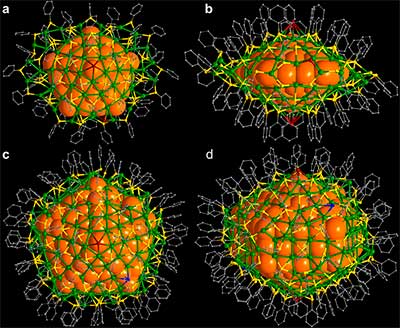Understanding Nanoclusters in Nanotechnology
Definition: Nanoclusters refer to aggregates of atoms or molecules that consist of anywhere from a few to thousands of atoms. These entities bridge the gap between individual atoms or molecules and bulk materials, exhibiting unique physical, chemical, and optical properties that are not found in their isolated or bulk counterparts. Nanoclusters play a pivotal role in various applications, including catalysis, electronics, and biomedicine, due to their size-dependent properties.

Formation and Characteristics
Nanoclusters are formed through various methods, including physical vapor deposition, chemical vapor deposition, and sol-gel processes. These methods allow precise control over the size and composition of the nanoclusters, which in turn dictate their unique properties such as melting point, magnetic behavior, and electronic properties.
Applications of Nanoclusters
The unique properties of nanoclusters find applications in several fields:
- Catalysis: Nanoclusters can serve as highly efficient and selective catalysts for various chemical reactions due to their high surface area and tailored electronic properties.
- Optoelectronics and Sensing: The size-dependent optical properties of nanoclusters make them attractive for applications in light-emitting diodes, solar cells, and optical sensors.
- Biomedicine: Nanoclusters can be functionalized with biomolecules, making them suitable for applications such as targeted drug delivery, bioimaging, and biosensing.
- Energy Storage: Nanoclusters have been explored for use in electrochemical energy storage devices, such as batteries and supercapacitors, due to their high surface area and unique redox properties.
Key Features and Benefits
Nanoclusters are distinguished by several key features:
- Size-Dependent Properties: The physical and chemical properties of nanoclusters can be finely tuned by controlling their size, composition, and surface modification.
- High Surface-to-Volume Ratio: Nanoclusters possess a high surface-to-volume ratio, making them highly reactive and suitable for catalysis and sensor applications.
- Quantum Effects: At the nanoscale, quantum size effects become significant, leading to unique optical and electronic properties that are exploited in quantum computing and photovoltaics.
Challenges and Future Directions
Despite their potential, the development and application of nanoclusters face challenges:
- Controlled Synthesis: Achieving precise control over the size, shape, and composition of nanoclusters remains a challenge that impacts their properties and applications.
- Stability: Nanoclusters can be prone to aggregation or dissolution, affecting their performance and reliability in applications.
Technological Advancements
Recent advances in synthesis methods, characterization techniques, and computational modeling have significantly enhanced our understanding and utilization of nanoclusters. These advancements promise to overcome existing challenges and open up new avenues for research and applications in nanotechnology and beyond.
Environmental and Safety Considerations
The environmental impact and safety of nanoclusters are important considerations. Research is ongoing to assess their toxicity, environmental fate, and potential hazards to ensure their responsible use and disposal.
Further Reading
Science and Technology of Advanced Materials , Metal nanoclusters: from fundamental aspects to electronic properties and optical applications
Chemical Society Reviews, Atomically precise alloy nanoclusters: syntheses, structures, and properties
